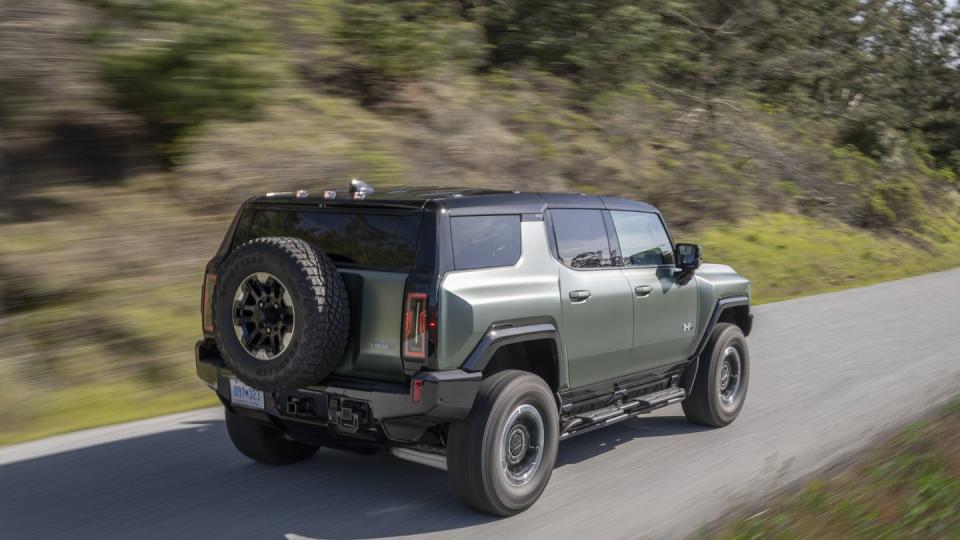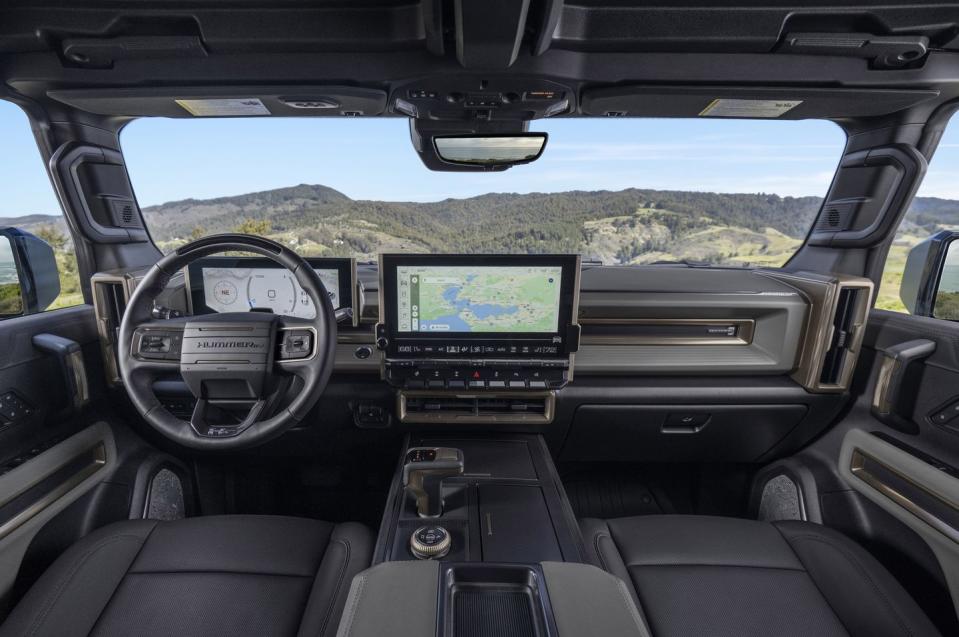2024 Hummer EV SUV Tested: Everything, Everywhere, All at Once

UPDATE 5/31/23: This review has been updated with test numbers.
Every few years a vehicle seemingly born of a "What the hell, let's do it!" attitude debuts. That go-for-it approach usually creates track-ready sports cars. Giving design and engineering what they want might not be cost efficient, but with the right people, it can result in something interesting.
In this case, the approach created the 2024 GMC Hummer EV SUV. It's the fraternal twin of the Hummer pickup, and everything from the rear doors forward is identical. An 8.9-inch wheelbase reduction shrinks cargo space relative to the pickup but keeps rear-seat space intact. The wheelbase might be shorter, but let's provide some perspective: The SUV's 126.7-inch wheelbase is still vast, coming within half an inch of a 1973 Lincoln Continental's.
The Hummer pickup weighs 9640 pounds (a weight that required a trip to the truck scales because it was too much for our scales), but the SUV isn't quite as heavy: 8660 pounds. Still, you may want to think twice before crossing bridges rated at four tons. The weight loss comes primarily from the SUV's smaller battery pack. Instead of 24 battery modules, the SUV has just 20 packaged below the floor, and that low-down mass leads to a stable feel. GMC estimates up to 314 miles of range, but the 170.0-kWh pack delivered 250 miles of range in our 75-mph highway test.
At a Level 2 hookup, the Hummer SUV can recharge at up to 19.2 kilowatts. Connect to a DC fast-charger—the beer bong of the EV world—and the Hummer will throw back nearly 300 kilowatts. In our testing, the Hummer SUV required 128 minutes to charge from 10 to 90 percent and averaged a pull of 78.0 kilowatts over that period. Meanwhile, the supplied home cord can deliver up to 7.7 kilowatts when configured with its swappable 240-volt NEMA 14-50 plug end. The Hummer can also share its electricity with EVs in need via an available accessory cable that can flow electrons at a rate of 6.0 kilowatts, donating about 10 miles per hour.

That smaller battery pack limits the combined output of the three motors from 1000 horsepower in the pickup to 830 horses here. (A 625-hp two-motor setup will arrive later.) The tri-motor powertrain has a launch-control mode that GMC calls Watts to Freedom, or WTF, because, well, WTH. It lowers the SUV's body by 3.5 inches, prepares the battery, and allows for a 3.4-second rip to 60 mph. This big beast also storms through the quarter-mile in 11.9 seconds at 112 mph. When not in WTF launch mode, the Hummer doesn't make full power until 70 mph or so. The difference is evident in our 5-to-60-mph test: 4.1 seconds in WTF mode versus 5.2 seconds otherwise. Accelerating hard with the suspension in a higher mode squats the rear end and points the nose skyward. Stopping is somewhat impressive for something weighing over four tons, with the Hummer taking 199 feet to haul itself down from 70 mph.
Shorn of its body, the structure is built around the battery module with suspension mounting points that attach to unequal-length control arms. Off-road-equipped Hummers get knobby 35-inch tires on 18-inch wheels, while opting for the on-road version earns 22-inch wheels and LT305/55R-22 Goodyear Wrangler Territory AT tires. To increase rear-suspension articulation, which keeps the wheels on the ground over uneven terrain, off-road models ditch the rear anti-roll bar but gain a couple of underbody cameras that can chronicle the abuse suffered by the front and rear tires.
No matter which chassis you select, you get air springs that offer 13.0 inches of travel and up to 16.0 inches of clearance. All but the base model get four-wheel steering that helps disguise the mass you're commanding. At slow speeds, the rear end tucks around, giving the SUV a turning circle of 35.4 feet, tighter than a Chevy Bolt EUV's. At higher speeds, the rear-axle steering stabilizes the handling, though the tires' grip limits are low—we measured just 0.76 g on our skidpad and noted that the Hummer's understeer was "excessive." That's in WTF mode, mind you, which puts the vehicle in the lowest ride height. Take it out of that mode, and the skidpad figure drops to just 0.69 g.
Relax a little, and you'll discover that GM's Super Cruise works brilliantly. It's not an aggressive driver, but it will make lane changes on its own (passing on the left only) and then return to the right lane after completing the pass.
Inside, the SUV is nearly identical to the pickup. The cabin is as wide as you'd expect of a Hummer, and the floor is flat. Hard plastics on the lower part of the instrument panel are disappointing in a vehicle this expensive, but there's a 12.3-inch digital gauge display in front of the driver and a central 13.4-inch touchscreen that either the driver or passenger can use. GMC wisely kept some physical switchgear for climate-control functions and still clearly builds interiors with gloved hands in mind. Unlike in the pickup, the large center screen doesn't reflect annoyingly in the back glass. Rear-seat space is excellent. The cargo area is big enough for five occupants' luggage, but the high floor means loading heavy bags requires a heave-ho.
The Hummer EV SUV defies a lot of expectations. It accelerates like a sports car, handles like it's thousands of pounds lighter, and charms with the improbability of it all. There's not much on-pavement grip, but it's capable off-road, and you'll never have to worry about sucking water into the intake. There’s a lot of weight here, but there's also a lot of everything. Born of attitude and consequently full of attitude, the Hummer EV SUV left us thoroughly entertained.
You Might Also Like

 Yahoo Autos
Yahoo Autos 
